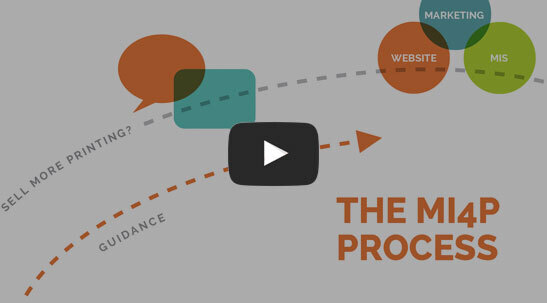Stop Treating AI Like Google (and Start Using It Like Your Assistant Coach)

How smart printers are getting better results by leading the conversation, not just asking for answers. If you’re like most print shop owners I talk to, you’ve probably dabbled with AI by now. Maybe you’ve even typed something like: “Write me a follow-up email for a customer who hasn’t responded.” And what came back was… fine. Not great. Not personal. Definitely not the kind of thing that makes you think, “Wow, this sounds just like me!” If that’s been your experience, here’s the good news: It’s not your fault. You’re just using the wrong playbook. You Don’t Win the Game By Reading the Playbook Alone If you’ve ever watched a high school football game—or better yet, had a kid on the team—you know the coach doesn’t just hand out a fat binder of plays and yell, “Good luck out there!” (At least, we hope not.) The real value of a good coach is in the conversation that happens before the play gets called: “What’s the defense showing you?” “What’s working today that didn’t work last game?” “How do we adjust so you don’t get flattened again on third down?” AI works the same way. Most people are using it like Google—asking for quick,
Small Orders, Big Decisions: Managing Client Expectations

In last month’s article, Sam Lewis began setting minimum charges for Print Perfect, a necessary but challenging step to sustain his business. Now, he faces an equally tough task: communicating these changes to his loyal clients. As concerns and questions arise, Sam learns that managing expectations is just as critical as implementing new policies. In this installment, we see how Sam navigates client conversations with transparency and tact, working to preserve trust while staying true to his business goals. Since implementing minimum charges, Sam had mixed feelings. Some clients understood and appreciated the change, but others raised concerns. Now, he faced the next challenge: how to communicate these changes in a way that would keep clients satisfied without undermining his business goals. One morning, as he prepared his usual cup of coffee, Laura approached him. “Sam, I think we need a consistent way to explain these new charges. We’ve been doing it one conversation at a time, and it’s a bit overwhelming.” Sam nodded, “You’re right. It’s time we establish a clear approach.” Building a Communication Strategy Sam decided to craft a message he could use across all client interactions. He drafted an email that outlined the reasons for the
Small Orders, Big Decisions: Setting Boundaries with Minimum Charges

Last month, we met Sam Lewis, owner of Print Perfect, as he began to face the financial strain caused by small, low-margin print jobs. With his shop’s resources stretched thin, Sam realized that change was necessary. Now, he takes his first step toward addressing the issue: introducing minimum charges for small jobs. In this article, Sam navigates the delicate balance between setting boundaries and preserving the relationships that make his business special. Will his clients understand, or will the change test their loyalty? Sam had been contemplating it for days: how do you set minimum charges without alienating loyal customers? He glanced over at Laura, his production manager, who was already juggling a backlog of small jobs, each barely covering costs. “Laura,” he began, “I think it’s time we take action on those minimum charges.” Laura nodded. “I agree. We’re stretched too thin, Sam. But we need a clear way to communicate this so clients understand why it’s necessary.” Sam paused, deep in thought. “I don’t want them to think we’re just hiking prices. How do we help them see the value behind it?” Crunching the Numbers Determined to dig deeper, Sam decided to analyze trends over the past
Sell More Printing: Breaking the 4-Minute Mile with AI

Welcome back to another edition of Sell More Printing, where we explore real-world sales and marketing strategies that you, as a printer, can adapt to boost your business. Today, we’re drawing inspiration from a historic athletic achievement to explore how embracing Artificial Intelligence (AI) can revolutionize your printing business. Breaking the 4-Minute Mile Before 1954, medical experts and athletic professionals deemed the idea of running a mile in under four minutes impossible. It wasn’t until May 6, 1954, when Roger Bannister accomplished this feat, that the barrier was broken. This achievement not only proved the experts wrong but also inspired many others to follow suit. Within a few years, over 50 athletes had broken the 4-minute mile, demonstrating the power of breaking mental and perceived physical barriers. Similarly, the adoption of AI in business has faced skepticism. For years, many have seen AI as a futuristic, impractical technology. However, continuing advancements and successful implementations across various industries have shown that AI can indeed drive significant improvements in efficiency, customer engagement, and cost savings. Training for AI Excellence Roger Bannister did not achieve his record-breaking 4-minute mile by chance; it was the result of strategic preparation. In the same way, to achieve true AI productivity,
Sell More Printing: From AI Doubts to Results

Welcome back to another edition of Sell More Printing, where we explore real-world sales and marketing strategies that you, as a printer, can adapt to boost your business. This month, we’re going deep into the world of Artificial Intelligence (AI) to consider how it can do real work that’s better, faster, and less expensive. The AI Journey: From Doubter to Believer My exploration into AI began with a sense of curiosity and a touch of skepticism. As someone who has always been interested in innovative solutions to enhance our marketing services at Marketing Ideas For Printers, I couldn’t ignore the growing buzz around AI. Initially, I focused on understanding how AI could help improve our marketing strategies, but what I discovered was far more profound. The challenge that set me on this path was to create an AI tool capable of delivering improvements in the order of 1,000 times better when measuring the time and money required to complete an existing task or process. The goal seemed ambitious, if not impossible. However, I embraced it because achieving a 1000x improvement would allow me to share this knowledge with you, helping you discover your 1000x improvements. The 1000x AI-powered Budgeted Hourly
Embracing AI in Printing: The Missing Ingredient for Success

Artificial intelligence (AI) is transforming industries worldwide, and the printing industry is no exception. While many printers have dabbled in AI, few have harnessed its full potential. The missing ingredient? Training. As printers, we are constantly looking for ways to improve efficiency, reduce costs, and provide better service to our customers, and AI offers solutions to all these challenges and more. By leveraging AI, you can streamline your operations, automate routine tasks, and gain insights that were previously unattainable. The Power of AI Training AI training isn’t about becoming an expert overnight; it’s really about understanding how to leverage AI effectively for your print business. Earlier this year, I joined a community of AI experts and was transformed from a novice to a proficient user in just weeks. The AI Foundations course I took was the catalyst for this transformation, providing an intensive, hands-on experience that took me from a beginner (white belt) AI user to an advanced user (black belt). Hiya! Real-World Success with AI For Printers Let me translate this training into what it quickly became. As part of my AI training, I created an AI tool to help printers conduct a budgeted hourly rate (BHR) study. Typically,


